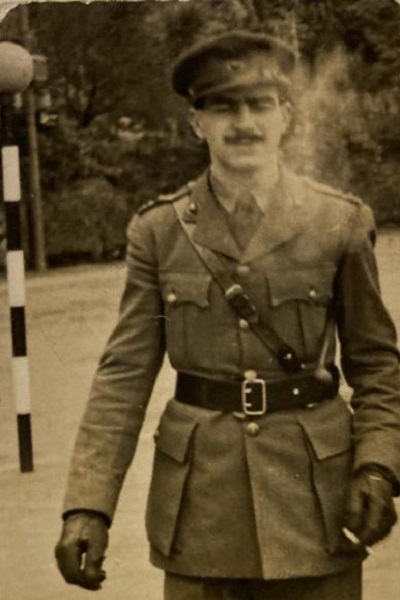Hiles, Waldo Harry Bentley
Personal Information
| Rank | S/L |
| Forename(s) | Waldo Harry Bentley |
| Surname | Hiles |
| Gender | M |
| Age | 29 |
| Decorations | DSO, DFC |
| Date of Death | 24-08-1943 |
| Next of Kin | Son of Thomas Henry Hiles and Rosamund Sarah Hiles (née Jones). They married on 10 December 1910 in Gowerton, Swansea. Brother of Rosamund Yontha Hiles and William Jenkin Hiles. Husband of Elizabeth Hiles (nee Shanley). They married in Witney, Oxfordshire, the marriage being registered in Q4 1940. Father of Jenkin Waldo Hiles (born 15 October 1938 in Islington). |
Aircraft Information
| Aircraft | Short Stirling III |
| Serial Number | EH925 |
| Markings | IC-C |
Memorial Information
| Burial/Memorial Country | United Kingdom |
| Burial/Memorial Place | Runnymede Memorial |
| Grave Reference | Panel 118. |
| Epitaph |
IBCC Memorial Information
| Phase | 2 |
| Panel Number | 182 |
Enlistment Information
| Service Number | 121330 |
| Service | Royal Air Force Volunteer Reserve |
| Group | 3 |
| Squadron | 623 |
| Trade | Pilot |
| Country of Origin | United Kingdom |
Miscellaneous Information
| Born 1 September 1913, Swansea, he was educated at Llandovery College where he developed a keen interest in hockey. Known as Wally. He bagn his flying career with No. 49 Squadron at RAF Fiskerton, where he flew a total of 29 operations, following which he was 'screened from operations' at No. 14 OTU and No. 19 OTU, amongst other training units, during which time he married. He was then posted to No. 218 Squadron for his second tour, where he flew 20 further operations. On 24 March 1943 he was posted to No. 3 Group HQ at Exning House, Suffolk as staff officer. On 12 August he was visiting Downham Market for reasons unknown, but almost certainly not to fly an operation. The reason for him doing so is equally unknown, but can probably be put down to his well known reputation as a have-a-go leader of men. He flew with a scratch crew including his own former rear gunner. |
| His DSO was promulgated without citation in the London Gazette on 11 June 1943, however the citation read "Squadron Leader Hiles has been flying on operations since May, 1941, and has completed numerous sorties since being awarded the D.F.C. He always presses home his attacks in the most determined manner, flying at low altitude regardless of enemy opposition.” |
| On 20 February 1945, Waldo’s wife collected his Distinguished Service Order from the King at Buckingham Palace. It must have been a mixed day of emotions for Elizabeth. |
| His DFC citation reads "In November 1942 this officer captained a heavy bomber detailed to attack Stuttgart. At one point on the outward flight, Flight Lieutenant Hiles brought his aircraft down to 200ft while his gunners attacked a goods train and put it out of action. He then flew on to his objective and bombed it. During the return journey, attacks were made on targets on the ground, including four separate attacks on goods trains and in each instance, locomotives were set on fire, F/Lt Hiles also attacked an enemy aircraft on an airfield. This officer who has completed a large amount of sorties has invariably displayed outstanding skill and daring.” |
Commonwealth War Graves Commission
Fellow Servicemen
Please note that this list gives all the losses aboard the quoted aircraft and occasionally these may have occurred on an earlier date when the aircraft was not itself lost. Please check the dates of death carefully.
Last Operation Information
| Start Date | 23-08-1943 |
| End Date | 24-08-1943 |
| Takeoff Station | Downham Market |
| Day/Night Raid | Night (37% moon) |
| Operation | Berlin. 727 aircraft, 56 losses (7.9%)- the greatest loss in a single raid so far in the war. Sequential marking was used to keep the main force on course. A Master Bomber approach was also used (W/C J E [Johnny] Fauquier). PFF were unable to locate the centre of Berlin using H2S and instead marked the southern suburbs. The main force arrived late and many cut a corner, making their arrival point incorrect. As might be expected for Berlin, the flak and fighter defences were formidable. Nevertheless, this was the most serious raid on Berlin so far in the war. Much of the government district was badly damaged and 20 ships were also sunk. 854 people were killed, many of whom had failed to take refuge in air raid shelters. |
| Reason for Loss | Shot down by a night-fighter and crashed south of Zossen |
